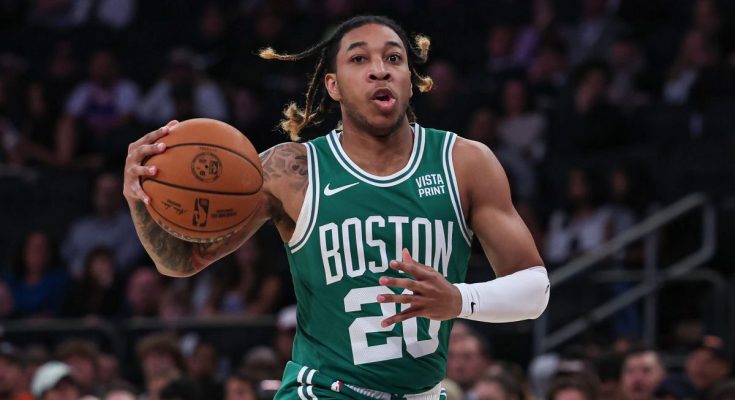Boston Celtics Waive JD Davison to Reclaim Salary Cap Flexibility and Return Officially Under NBA’s Strict Second Apron Threshold
The Boston Celtics on July 24, 2025 made a decisive and financially motivated roster move by waiving guard JD Davison. Davison, who they had extended with a non‑guaranteed $2.27 million team option for the 2025‑26 season, was released, and that move pushed Boston back below the NBA’s punitive second luxury tax apron. That side of their roster now has latitude to pursue trades, signings, and maneuver without triggering the steep penalties tied to exceeding that threshold.
Davison, aged 22, was drafted 53rd overall in 2022 out of Alabama and spent most of his first three seasons on a two‑way contract with the Celtics before being moved onto a standard deal in April 2025 . While his NBA minutes were limited—36 games, averaging around 1.9 points in under six minutes per contest—he lit up the G League, earning 2024‑25 G League MVP honours after posting roughly 25 points, 7½ assists and over 5 rebounds per game with the Maine Celtics .
Boston had already made cost‑cutting moves earlier in the offseason, notably trading Jrue Holiday and Kristaps Porzingis, in an effort to escape the heft of second‑apron penalties . However, subsequent additions such as Luka Garza and Josh Minott nudged them back above the apron. Waiving Davison was a targeted and surgical decision to shed roughly $2.3 million from the books and restore cap status beneath the second apron level .
Remaining under the second apron matters greatly. Teams above that threshold face strict construction constraints: they cannot use the taxpayer mid‑level exception, cannot aggregate salaries in trades (meaning they cannot bundle multiple smaller salaries to match a larger one), cannot send or receive cash in deals, cannot use prior trade exceptions, and cannot trade first‑round picks more than seven years out. Staying above the limit more than two seasons in a rolling four‑year window can freeze or downgrade trading rights for future draft picks . By contrast, once Boston is under the apron, it regains more flexibility to sign certain free agents, use exceptions, and engage in broader trade structures.
Financially, the second apron carries enormous costs. As of late May 2025, projections showed Boston $4.4 million over the apron, with their payroll ballooning to around $227.8 million. That level triggered steep luxury tax penalties and repeater surcharges, potentially doubling or tripling annual luxury tax bills and pushing total spend toward half a billion dollars . To avoid further escalation, shedding salary—even relatively modest sums like Davison’s—became essential.
The decision also freed up a roster spot, giving Boston the option to pursue a veteran signing or trade addition while still remaining under the apron. But Celtics insiders caution that any further spending—even to bring in a low‑salary contributor—could nudge the team back over the threshold, reinstating restrictions .
While Davison’s NBA contributions were minimal, his waiving does open the door for him to pursue two‑way or standard opportunities elsewhere; he remains eligible for another two‑way deal—but not in Boston, as he exhausted his maximum three‑year term in that role with the club . His G League dominance suggests he could latch on elsewhere, perhaps as high‑upside depth or developmental guard.
Strategically, this move reflects Boston’s broader retooling: pivoting from hopeful retention of fringe prospects toward cap flexibility and controlled roster optimization. They remain tied into mega‑contracts for superstars like Jayson Tatum and Jaylen Brown—which constitute the bulk of their salary load. Trading a high‑salary starter without acquiring matching salary would put them under the second apron easily, but offers the kind of relief needed to reconstruct the roster under manageable long‑term terms .
With avenues reopened, speculation swirls around potential interest in players like Ben Simmons, Anfernee Simons, or Georges Niang—each of whom fits the need for movable contracts, positional flexibility, or trade balance. None of those moves are imminent—but by shedding Davison, Boston’s front office has reaffirmed their commitment to navigating offseason deals within league rules, rather than being hamstrung by salary thresholds .
In summation, the Celtics’ waiver of JD Davison was not a commentary on his basketball potential but a calculated salary‑cap maneuver. It eliminates a non‑guaranteed $2‑plus million commitment, trims the roster under the second luxury tax apron, restores operational flexibility in trades and free agency, and reaffirms a methodical approach to reshaping a championship‑caliber team within crippling financial confines. For Davison, it marks the beginning of a new opportunity elsewhere; for Boston, it is a strategic reset toward sustainable flexibility.



